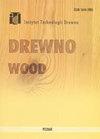APPLICATION OF SELECTED AGENTS FOR WOOD LIQUEFACTION AND SOME PROPERTIES OF PARTICLEBOARDS PRODUCED WITH THE USE OF LIQUEFIED WOOD
IF 0.9
4区 农林科学
Q3 MATERIALS SCIENCE, PAPER & WOOD
引用次数: 10
Abstract
This work presents the characteristics of wood liquefied using different types of solvents in terms of its application for binding particleboards. Standard pine particles from barked wood were used for the liquefaction experiments. The liquefaction reaction was carried out in high temperature conditions using a mixture of solvents from the polyhydroxy alcohol group, including glycerine, ethylene glycol, propylene glycol, diethylene glycol, and dipropylene glycol. The microstructure of both the liquefied wood and the liquefaction residues was determined by means of optical microscopy analysis. The basic parameters of the adhesive mixture modified with the liquefied wood, such as viscosity, pH and gel time were determined. Particleboards containing liquefied wood were produced. The following physicochemical and mechanical properties of the particleboards were measured: tensile strength, bending strength, modulus of elasticity, and formaldehyde content . The influence of the liquefying agent on the board properties was investigated. In all the tests, a control particleboard, bonded with a urea-formaldehyde adhesive resin with no inclusion of liquefied wood, was used for the purposes of comparison.木材液化剂的选用及液化木材生产的刨花板的一些性能
这项工作提出了木材液化的特点,使用不同类型的溶剂,在其应用绑定刨花板。液化实验采用了标准松木颗粒。液化反应在高温条件下进行,使用来自多羟基醇基团的混合溶剂,包括甘油、乙二醇、丙二醇、二甘醇和二丙二醇。用光学显微镜对液化木材和液化残渣的微观结构进行了分析。测定了液化木材改性胶黏剂的粘度、pH、凝胶时间等基本参数。生产了含有液化木材的刨花板。测量了刨花板的以下物理化学和机械性能:拉伸强度、弯曲强度、弹性模量和甲醛含量。研究了液化剂对板料性能的影响。在所有的测试中,为了进行比较,使用了一种对照刨花板,该刨花板与不含液化木材的脲醛粘合树脂粘合在一起。
本文章由计算机程序翻译,如有差异,请以英文原文为准。
求助全文
约1分钟内获得全文
求助全文
来源期刊

Drewno
MATERIALS SCIENCE, PAPER & WOOD-
CiteScore
1.10
自引率
12.50%
发文量
0
审稿时长
>12 weeks
期刊介绍:
Wood. Research papers. Reports. Announcements" ("Drewno") is an international scientific journal that publishes original results of innovatory basic and applied research concerning technological, technical, economic and ecological issues important for the wood science and forest-based industries, including their environment, and interesting to the international recipients. "Drewno" is an Open Access biannual journal.
Aims and scope:
wood science: anatomy, biology, chemistry, physics
wood mechanical and chemical technology, inter alia, sawmilling, composite wood products, wooden construction, furniture making, wood pulp, paper making
material engineering, biocomposites, nanocomposites
material management
environmental protection, safety of the processes, products and working stations
biotechnology
bioenergy, biofuels
forestry: harvesting and wood quality
wood-based industries economics
The Editorial Board of the journal especially welcomes articles concerning increase in wood resources (wood mobilisation); innovative composites and lignocellulosic materials; new trends in the protection, modification and finishing of wood; biorefining of raw wood material; "green" building; new technologies of wood waste recycling; sustainable development; innovation management; and business networks.
 求助内容:
求助内容: 应助结果提醒方式:
应助结果提醒方式:


